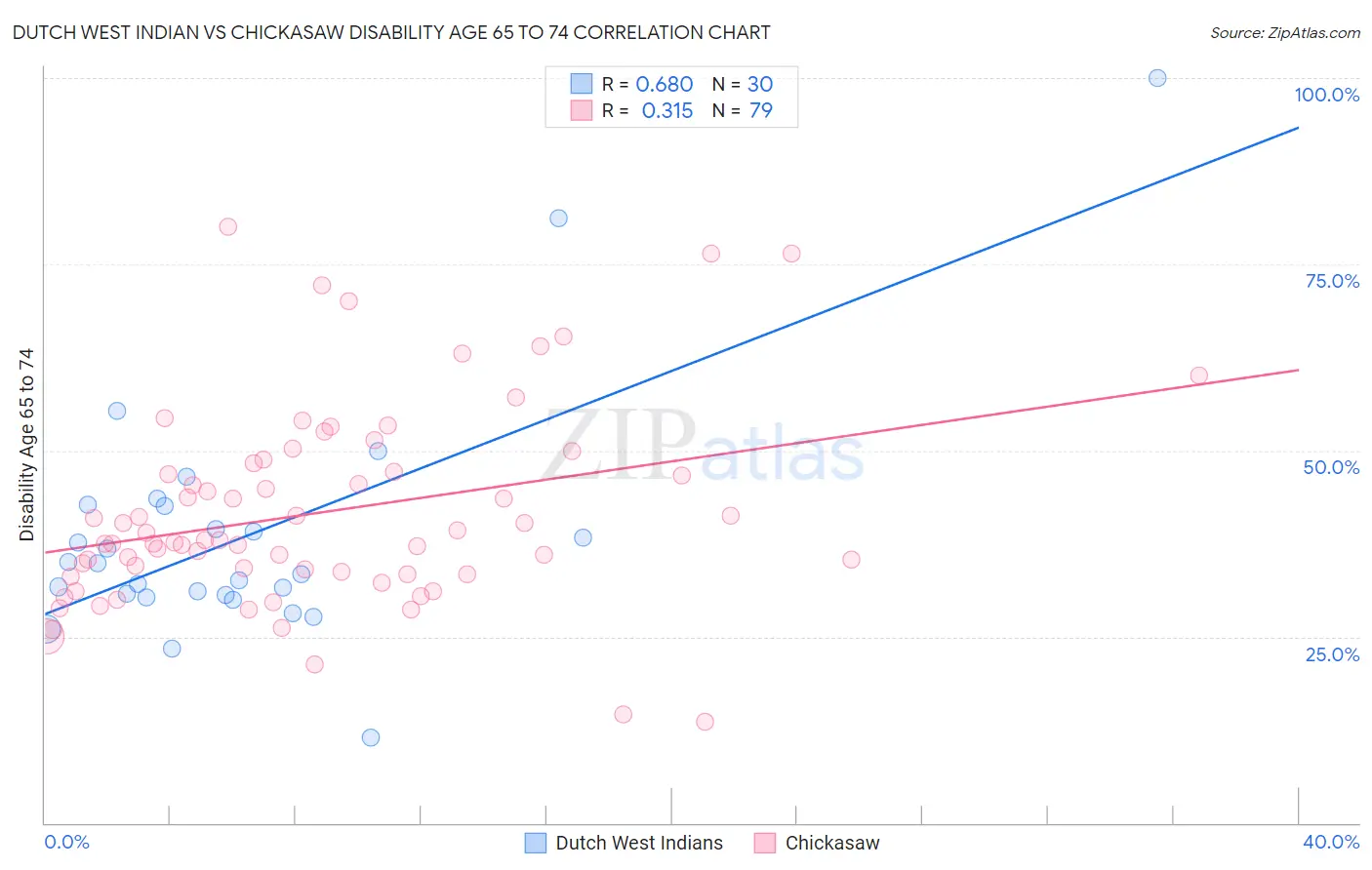Dutch West Indian vs Chickasaw Disability Age 65 to 74
COMPARE
Dutch West Indian
Chickasaw
Disability Age 65 to 74
Disability Age 65 to 74 Comparison
Dutch West Indians
Chickasaw
29.6%
DISABILITY AGE 65 TO 74
0.0/ 100
METRIC RATING
325th/ 347
METRIC RANK
30.2%
DISABILITY AGE 65 TO 74
0.0/ 100
METRIC RATING
331st/ 347
METRIC RANK
Dutch West Indian vs Chickasaw Disability Age 65 to 74 Correlation Chart
The statistical analysis conducted on geographies consisting of 85,748,630 people shows a significant positive correlation between the proportion of Dutch West Indians and percentage of population with a disability between the ages 65 and 75 in the United States with a correlation coefficient (R) of 0.680 and weighted average of 29.6%. Similarly, the statistical analysis conducted on geographies consisting of 147,556,011 people shows a mild positive correlation between the proportion of Chickasaw and percentage of population with a disability between the ages 65 and 75 in the United States with a correlation coefficient (R) of 0.315 and weighted average of 30.2%, a difference of 2.2%.

Disability Age 65 to 74 Correlation Summary
| Measurement | Dutch West Indian | Chickasaw |
| Minimum | 11.5% | 13.6% |
| Maximum | 100.0% | 80.0% |
| Range | 88.5% | 66.4% |
| Mean | 38.5% | 41.7% |
| Median | 34.1% | 38.0% |
| Interquartile 25% (IQ1) | 30.5% | 33.3% |
| Interquartile 75% (IQ3) | 42.5% | 48.3% |
| Interquartile Range (IQR) | 12.0% | 14.9% |
| Standard Deviation (Sample) | 16.6% | 13.4% |
| Standard Deviation (Population) | 16.4% | 13.3% |
Demographics Similar to Dutch West Indians and Chickasaw by Disability Age 65 to 74
In terms of disability age 65 to 74, the demographic groups most similar to Dutch West Indians are Yakama (29.6%, a difference of 0.23%), Apache (29.7%, a difference of 0.38%), Seminole (29.4%, a difference of 0.45%), Hopi (30.0%, a difference of 1.3%), and Puerto Rican (29.1%, a difference of 1.4%). Similarly, the demographic groups most similar to Chickasaw are Creek (30.2%, a difference of 0.010%), Choctaw (30.2%, a difference of 0.040%), Native/Alaskan (30.4%, a difference of 0.62%), Hopi (30.0%, a difference of 0.84%), and Colville (30.5%, a difference of 1.1%).
| Demographics | Rating | Rank | Disability Age 65 to 74 |
| Nepalese | 0.0 /100 | #318 | Tragic 28.0% |
| Arapaho | 0.0 /100 | #319 | Tragic 28.1% |
| Cherokee | 0.0 /100 | #320 | Tragic 28.2% |
| Comanche | 0.0 /100 | #321 | Tragic 28.3% |
| Aleuts | 0.0 /100 | #322 | Tragic 28.4% |
| Puerto Ricans | 0.0 /100 | #323 | Tragic 29.1% |
| Seminole | 0.0 /100 | #324 | Tragic 29.4% |
| Dutch West Indians | 0.0 /100 | #325 | Tragic 29.6% |
| Yakama | 0.0 /100 | #326 | Tragic 29.6% |
| Apache | 0.0 /100 | #327 | Tragic 29.7% |
| Hopi | 0.0 /100 | #328 | Tragic 30.0% |
| Choctaw | 0.0 /100 | #329 | Tragic 30.2% |
| Creek | 0.0 /100 | #330 | Tragic 30.2% |
| Chickasaw | 0.0 /100 | #331 | Tragic 30.2% |
| Natives/Alaskans | 0.0 /100 | #332 | Tragic 30.4% |
| Colville | 0.0 /100 | #333 | Tragic 30.5% |
| Alaska Natives | 0.0 /100 | #334 | Tragic 30.6% |
| Cheyenne | 0.0 /100 | #335 | Tragic 31.1% |
| Yuman | 0.0 /100 | #336 | Tragic 31.5% |
| Houma | 0.0 /100 | #337 | Tragic 32.3% |
| Alaskan Athabascans | 0.0 /100 | #338 | Tragic 32.4% |